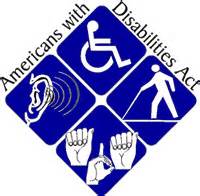The 25th anniversary of the signing of the ADA offers an opportune time to encourage businesses to educate the workforce about the ADA and disability employment issues. Informing employees, beyond simply posting an equal opportunity poster, can benefit businesses by creating a more knowledgeable and inclusive workforce, reducing the likelihood of discrimination through awareness, and improving productivity by recognizing value in providing reasonable accommodations. There are many ways to educate the workforce about the ADA and reasonable accommodation. Consider these strategies:
Train HR Professionals, Supervisors, and Managers. JAN cannot stress this enough. Train management staff on the ADA and accommodations – early and often. These key employees will have a significant impact on job performance success rates if properly informed, trained, and equipped with the information and tools necessary to comply with the ADA and engage in the interactive process. Here are some training tips that will benefit any management team:
- Inform staff about the basic principles of the ADA and reasonable accommodation. They must know the employer’s obligations under the ADA, general accommodation requirements, and how to avoid discrimination.
- Train staff how to recognize and respond to an accommodation request. This is where a formal reasonable accommodation procedure will help management engage and implement accommodations in a way that is fair and consistent. When an employee indicates that a medical condition is causing a work-related problem, a supervisor or manager should treat it as an accommodation request until a definite determination is made.
- Limit the sharing of medical information. Employee medical information should be shared with only those who are considered to be on a need-to-know basis. In many cases, medical information is provided to HR, however, supervisors and managers often do not need to know an employee’s specific medical impairment to implement accommodations. Details about the accommodation may be all that is needed. Knowing fewer details about an employee’s medical impairment will be beneficial when other employees ask questions about accommodations – the manager won’t be in a position to unnecessarily reveal information s/he is not aware of.
- Don’t perpetuate or tolerate harassment. Expect management staff to communicate respectfully and interact positively with employees who have accommodations, as should be expected with all employees. Management should refrain from making negative or derogatory remarks in response to an accommodation request or questions from co-workers about accommodations.
Implement a Reasonable Accommodation Policy … and Tell Everyone About It! There is no requirement under the ADA for employers to follow specific policies and procedures when trying to accommodate an applicant or employee with a disability. However, having a formal reasonable accommodation policy and procedures – and sharing them with everyone – is recommended. A formal process creates a standard of practice for HR professionals, managers, and supervisors to follow, which increases the likelihood that accommodation requests will be handled properly and consistently. When formal policies and procedures are shared with all employees, this helps all workers know about the ADA, how to request accommodations, what to expect after doing so, and also helps them understand (if they personally do not need accommodation) that other employees might be requesting and receiving accommodations. EEOC’s own accommodation procedures can be used as a model for employers who would like to draft their own. See, Procedures for Providing Reasonable Accommodation for Individuals with Disabilities.
Make a Statement! … About Reasonable Accommodation. Another way to educate the workforce about the ADA and accommodations is to be sure the organization has a formal reasonable accommodation statement that is widely disseminated. A reasonable accommodation statement can be included as part of an equal opportunity (EO) statement that makes it clear that the organization has no intention to discriminate on the basis of disability or other legally prohibited bases. Employers should consider including an EO/RA statement in job postings, employee handbooks, on websites and intranet sites, in on-line applications, and other sources of workplace policies distributed to applicants and employees. For sample reasonable accommodation and EO statements, see JAN’s Consultants’ Corner article,Making a Statement – About Reasonable Accommodation and Equal Opportunity.
Incorporate ADA & Accommodation Practices Into the Onboarding Process. The purpose of an onboarding process is to smoothly integrate new employees into their positions and company culture. The onboarding process should include information about the ADA and reasonable accommodation. If a new hire with a disability needs an accommodation, how will s/he know how to request it? Make sure new hires know that they can and should ask for an accommodation if they know or think they may need one. Many individuals who know they need an accommodation to do the job successfully will choose to make an accommodation request. Others may fear the job offer will be rescinded if they do so, and some may not be sure if they need an accommodation or may not know how to request what they need. To overcome these issues, the individual making the job offer or preparing the employee to start working can share information about the company’s desire to facilitate a smooth transition and integration for the new employee and explain various employment policies and procedures, including the organization’s reasonable accommodation policy. For more information, see JAN’s E-News article, Incorporate Reasonable Accommodation Practices into your Onboarding Process.
From the Job Accommodation Network http://askjan.org/enews/2015/Enews-V13-I3.htm#5






